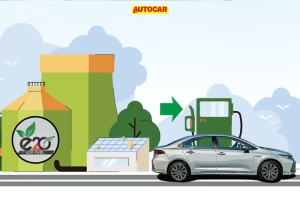GS2 – Governance

Context:
India achieved 20% ethanol blending (E20) in petrol by 2025, five years ahead of its original target under the National Biofuel Policy, and plans to reach 27% blending by 2030. Ethanol blending is a key component of India’s energy security and environmental strategy, aimed at reducing dependence on fossil fuels, lowering greenhouse gas emissions, and supporting domestic agriculture through sugarcane and other feedstocks.
Technical & Operational Challenges:
- Mileage Reduction:
E20 fuels reduce vehicle fuel efficiency by approximately 7%, while E100 (pure ethanol) can reduce efficiency by almost 30%, raising concerns over consumer acceptance. - Corrosion Risk:
Ethanol’s hygroscopic nature (water absorption) accelerates rust formation in older vehicles, particularly two-wheelers, posing maintenance challenges. - Ignition Delay:
Higher ethanol content demands higher ignition temperatures, which can impair cold-start performance and engine responsiveness, especially in older cars. - Disclosure Gap:
Many fuel stations do not provide clear information on ethanol content, limiting consumer awareness and informed decision-making. - Price Disadvantage:
Currently, ethanol blends are priced close to petrol, offering no significant economic incentive for consumers. - Warranty Risk:
Vehicles manufactured before 2023 may void manufacturer warranties if they use fuels above E10, creating consumer hesitation. - Evidence Gap:
Long-term effects of ethanol blends on engine durability and vehicle lifespan are not fully studied, requiring more empirical data.
Global Benchmark – Brazil’s Model:
- Brazil pioneered ethanol blending during the 1970s oil crisis, combining technological innovation, supportive pricing policies, and flexible consumer choice.
- Flex-Fuel Technology:
Vehicles were designed to operate seamlessly on both petrol and ethanol, ensuring compatibility and reducing engine damage risks. - Retail Choice:
Fuel stations offered multiple blends (E18–E27) and pure hydrous ethanol (E100), allowing consumer preference to guide adoption. - Price Alignment:
Government interventions maintained ethanol at 25–35% cheaper than petrol, incentivising widespread use. - Phased Adoption:
Gradual rollout minimized risks to older vehicles, ensuring a smooth transition to higher ethanol blends without compromising engine performance.




